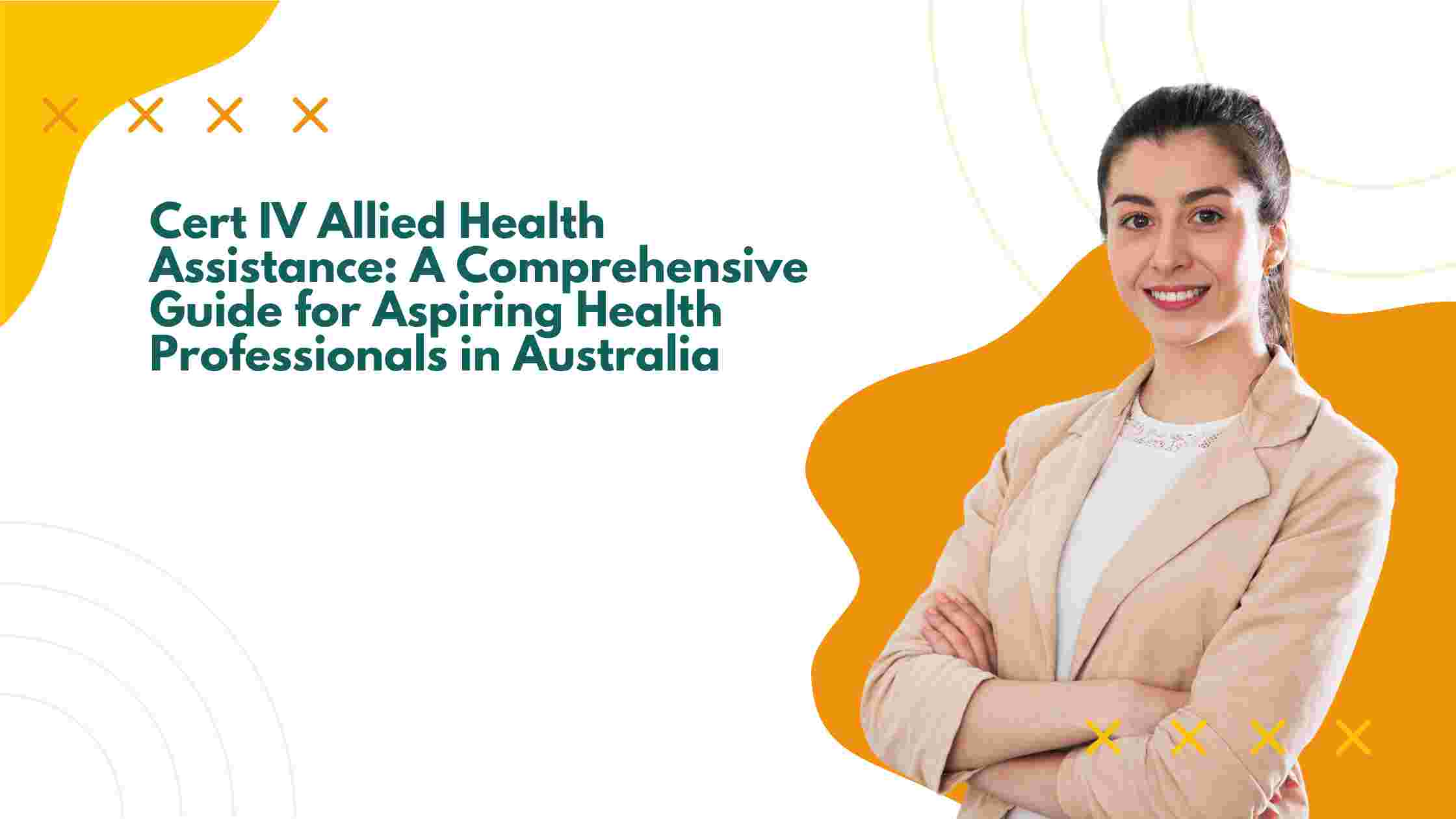In Australia’s growing healthcare sector, the demand for skilled support staff is rapidly increasing. Among the most popular pathways to a rewarding career in healthcare is the Certificate IV in Allied Health Assistance. This nationally recognised qualification not only opens the door to various support roles in medical, aged care, and rehabilitation settings but also acts as a bridge toward further education and professional development. In this comprehensive guide, we explore everything you need to know about the Cert IV Allied Health Assistance course — from its structure and career outcomes to eligibility, skills gained, and how it fits within Australia’s broader healthcare landscape.
Introduction to Allied Health Assistance in Australia
Allied health professionals play a vital role in the Australian healthcare system. They include physiotherapists, occupational therapists, speech pathologists, and dietitians — all supported by Allied Health Assistants (AHAs). These assistants ensure patients receive timely and effective care by helping implement therapeutic plans under professional supervision.
The Certificate IV in Allied Health Assistance is designed for individuals seeking to work closely with such professionals. This qualification allows learners to specialise in areas like physiotherapy, occupational therapy, community rehabilitation, and more.
Why Choose Certificate IV in Allied Health Assistance?
There are many compelling reasons why aspiring healthcare workers in Australia opt for this qualification:
- High Employability: Australia’s aging population and increasing focus on community care mean growing opportunities for AHAs.
- Versatility: The qualification suits those who wish to work in hospitals, aged care centres, private practices, and rehabilitation facilities.
- Flexible Learning: Many institutions offer blended delivery (online and in-person), which is ideal for working adults.
- Professional Recognition: The Cert IV is recognised nationally, which helps in securing employment across various Australian states and territories.
Entry Requirements and Eligibility
Though prerequisites may vary by institution, the general entry requirements include:
- Completion of Year 10 or equivalent literacy and numeracy skills
- A valid Working with Children Check and/or National Police Check (required for placement)
- Physical ability to undertake clinical tasks
- Proficiency in English communication (especially for non-native speakers)
Some providers may require previous health-related qualifications or experience, especially if enrolling in specialised streams.
Course Structure and Core Units
The Certificate IV in Allied Health Assistance (CHC43015) typically comprises 16 units:
- 7 core units
- 9 elective units (based on specialisations)
Core Units Often Include:
- CHCCOM005 – Communicate and work in health or community services
- CHCDIV001 – Work with diverse people
- HLTAAP001 – Recognise healthy body systems
- HLTAHA001 – Assist with an allied health program
- BSBMED301 – Interpret and apply medical terminology appropriately
- HLTAHA009 – Assist in the rehabilitation of clients
- HLTWHS002 – Follow safe work practices for direct client care
Elective Streams:
- Physiotherapy Stream
- Occupational Therapy Stream
- Speech Therapy Stream
- Nutrition/Dietetics Stream
These electives allow you to tailor your learning based on your career interests.
Delivery Modes and Duration
Most Australian TAFEs and private RTOs (Registered Training Organisations) deliver the course in various formats:
- Full-time: Typically 12 to 18 months
- Part-time: Up to 24 months
- Blended Learning: A combination of online theory and in-person practicals
- Work Placement: Mandatory (usually 120–160 hours) in a real healthcare setting
Skills You’ll Develop
Throughout the course, learners acquire a broad range of practical and interpersonal skills:
- Assisting therapists in delivering rehabilitation programs
- Conducting group and individual therapy under supervision
- Understanding medical terminology and client documentation
- Observing and reporting client responses to treatment
- Maintaining clinical equipment
- Communicating effectively with clients and colleagues
- Applying workplace health and safety protocols
Career Outcomes and Pathways
Graduates with a Cert IV in Allied Health Assistance can pursue roles such as:
- Allied Health Assistant
- Physiotherapy Assistant
- Occupational Therapy Assistant
- Rehabilitation Assistant
- Speech Pathology Assistant
- Nutrition Support Worker
Work Settings Include:
- Public and private hospitals
- Rehabilitation centres
- Residential aged care
- Disability services
- Community health organisations
Further Study Options:
- Diploma of Community Services
- Bachelor of Health Science or Allied Health
- Certificate IV in Disability or Aged Care
This qualification also provides credit toward some university degrees, making it a stepping stone to further education.
Benefits of Studying in Australia
Choosing to study this certificate in Australia brings several advantages:
- Strong Industry Connections: TAFEs and RTOs often have existing partnerships with healthcare facilities.
- Work Placement Support: Many institutions help students find appropriate placement locations.
- Modern Facilities: State-of-the-art simulation labs and clinical training setups
- Qualified Trainers: Experienced professionals provide practical insights
- Student Support Services: Academic and career guidance, mental health support, and financial aid
Top Providers Offering Cert IV Allied Health Assistance
Here are some reputable training institutions across Australia:
- TAFE Queensland
- TAFE NSW
- TAFE SA
- Box Hill Institute (VIC)
- Chisholm Institute
- Australian College of Nursing
- Open Colleges (online/blended)
Each provider may differ in terms of delivery format, fees, and specialisation options.
Course Fees and Funding Options
The cost of studying Certificate IV in Allied Health Assistance in Australia varies by provider:
- Full Fee: Ranges between AUD 3,000 and AUD 8,000
- Subsidised Fee: Available for eligible students under government programs like:
- JobTrainer
- Smart and Skilled (NSW)
- Skills First (VIC)
- User Choice (QLD)
Check with your state-based funding body for eligibility.
Job Outlook and Salary in Australia
With the healthcare sector expected to grow rapidly, the demand for qualified Allied Health Assistants is strong:
- Job Growth: Steady growth projected through 2028
- Median Salary: AUD 55,000 to AUD 65,000 annually (can increase with experience and specialisation)
- Working Hours: Full-time, part-time, and casual options available
This makes it an ideal career for those seeking work-life balance, especially in family-oriented or regional settings.
Challenges and Realities of the Job
While the career is rewarding, it also comes with certain demands:
- Physically intensive tasks like lifting and mobility support
- Emotional resilience required when dealing with vulnerable populations
- Need for continuous learning and adapting to care protocols
- Documentation and reporting responsibilities
Who Should Study This Course?
This course is ideal for:
- School leavers passionate about healthcare
- Career changers wanting meaningful, people-focused work
- Individuals already working in aged care or disability support
- Anyone aiming to enter university for a health degree later on
Final Thoughts: Is Cert IV Allied Health Assistance Right for You?
If you’re looking to build a hands-on career where you directly impact people’s health and well-being, then the Certificate IV in Allied Health Assistance is a solid choice. It equips you with practical skills, real-world experience, and the opportunity to work across a range of care settings. Whether you’re entering the healthcare workforce or advancing your current role, this nationally recognised qualification offers flexibility, stability, and purpose.
Read more:







